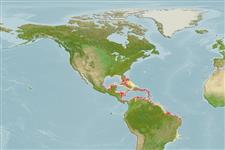Common names from other countries
Classification / Names / Names
Common names | Synonyms | Catalog of Fishes (gen., sp.) | ITIS | CoL | WoRMS
Environment: milieu / climate zone / depth range / distribution range
Ecology
Reef-associated; depth range 0 - 5 m (Ref. 97531). Tropical
Western Atlantic: USA, throughout the Caribbean and Brazil.
Length at first maturity / Size / Weight / Age
Maturity: Lm ? range ? - ? cm Max length : 3.7 cm TL male/unsexed; (Ref. 80375)
Found on sandy substrates with abundant coral rubble and rocks, near Thalassia sp. beds, in crevices of coral rocks, among clumps of Halimeda sp. and sandy reefs of polychaetes (Ref. 80375).
Life cycle and mating behavior
Maturity | Reproduction | Spawning | Eggs | Fecundity | Larvae
Members of the order Decapoda are mostly gonochoric. Mating behavior: Precopulatory courtship ritual is common (through olfactory and tactile cues); usually indirect sperm transfer.
Anker, A., C. Hurt and N. Knowlton. 2007. (Ref. 80375)
IUCN Red List Status (Ref. 130435)
CITES status (Ref. 108899)
Not Evaluated
Not Evaluated
Human uses
| FishSource |
Tools
More information
Age/Size
Growth
Length-weight
Length-length
Morphology
Larvae
Abundance
Internet sources
Estimates based on models
Preferred temperature
(Ref.
115969): 23.4 - 28.3, mean 27.2 (based on 384 cells).
Price category
Unknown.
